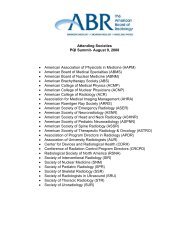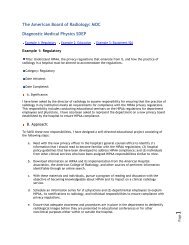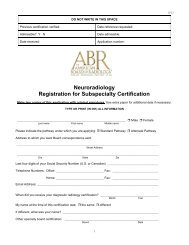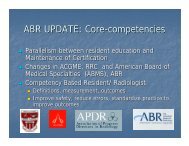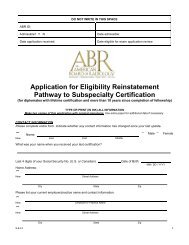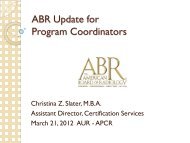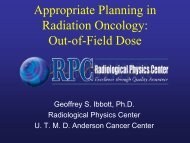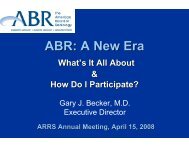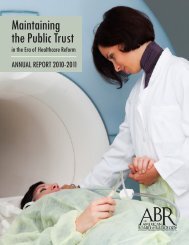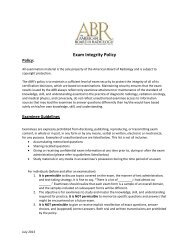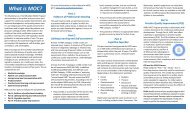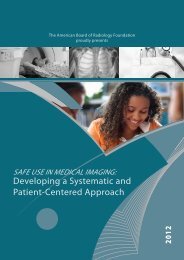ABR Update - The American Board of Radiology
ABR Update - The American Board of Radiology
ABR Update - The American Board of Radiology
Create successful ePaper yourself
Turn your PDF publications into a flip-book with our unique Google optimized e-Paper software.
<strong>ABR</strong> <strong>Update</strong><br />
Kay Vydareny, M.D.<br />
Associate Executive Director for Diagnostic<br />
<strong>Radiology</strong> and the Subspecialties
Topics<br />
• Exam security<br />
• Present exam<br />
• “<strong>Board</strong> eligible”<br />
• EOF (actually EOSoon)<br />
• MOC, briefly<br />
• Requirements <strong>of</strong> continuous certification<br />
• Questions
<strong>ABR</strong> and exam security<br />
• What is this “culture shift” and why worry<br />
about it now<br />
• Process <strong>of</strong> developing EOF – 400+ DR<br />
volunteers, 20+ committees<br />
• Don’t want to turn analysis/management items into<br />
memorization<br />
• Psychometrically sound to use some % previously used<br />
questions
So…what is OK<br />
• Directed study using Study Guides (available<br />
now on the website for Core exam), Practice<br />
Exam (available late 2012), pilot 2013<br />
• Group study based on the most frequently<br />
performed and critically important areas <strong>of</strong><br />
practice
What is not OK<br />
• Don’t attempt to remember questions in order<br />
to share specific questions/answers with other<br />
residents, individually or collectively.<br />
• Don’t receive lists <strong>of</strong> recalled questions and<br />
memorize them as a form <strong>of</strong> exam<br />
preparation.
Moving Forward<br />
• Residents will sign new attestations:<br />
• I have received and read the <strong>ABR</strong> Exam Security<br />
Policy, and have viewed the exam security video.<br />
• I understand the guidelines, responsibilities, and<br />
penalties as stated in the policy.<br />
• I pledge to honor and abide by the <strong>ABR</strong> Exam<br />
Security Policy. I will not engage in the<br />
memorization, recording, or sharing <strong>of</strong> recalled<br />
questions from <strong>ABR</strong> examinations. I understand<br />
that if I fail to adhere to the <strong>ABR</strong> Exam Security<br />
Policy, one or more <strong>of</strong> the consequences listed in<br />
the policy may apply to me and/or my residency<br />
training program.
Moving Forward<br />
• Program Directors and Coordinators will also<br />
sign attestations, as will Department Chairs.<br />
• <strong>The</strong> <strong>ABR</strong> has requested that ACGME include<br />
activity involving specific recalled items in<br />
PIF/site visitor questions.
Moving Forward<br />
• <strong>ABR</strong> exams given in computer testing centers<br />
incorporate security features:<br />
• Biometric identification<br />
• Security cameras<br />
• Proctoring<br />
• <strong>ABR</strong> can monitor and enforce exam security, but<br />
the bottom line is still individual<br />
pr<strong>of</strong>essionalism!!
Present oral exam: EON (now)<br />
• Core pilot 2012<br />
• All categories will be available.<br />
• Candidate will be assigned two appointments – one before<br />
and one after oral.<br />
• First category = assigned; second = own choice<br />
• Why take Opportunity to raise from condition to pass in<br />
two categories<br />
• Results available Friday May 25, 2012.<br />
• Final letters in July – AU-E, next steps
How long is your certificate valid<br />
• Continuous certification = no end date,<br />
beginning 2012<br />
• Must participate in MOC – yearly rolling lookbacks<br />
• First look-back in 3 years - “certified”<br />
• Need 3 years credits in CME, SAMSs, up-to-date license<br />
• If behind -“certified, not meeting MOC<br />
requirements” for one year<br />
• If behind in 4 years, could lose certificate
What is the future <strong>of</strong> the oral exam<br />
• May 2013 – last “big” exam<br />
• Nov 2013, May 2014, Nov 2014 – oral exams<br />
(full and conditions)<br />
• If fail Nov 2014 – move to Core Exam<br />
• If condition Nov 2014 – move to Certifying Exam<br />
(2 categories/conditioned category +essentials and<br />
NIS)<br />
• If fail, take entire Certifying Exam
How long are you “<strong>Board</strong> eligible”<br />
• 6 years after finish training<br />
• If not certified, must have additional year <strong>of</strong><br />
training.<br />
• Will have opportunity to take Core and<br />
Certifying twice/year.
Subspecialty Certificates<br />
• When earned, will have no end date; contingent<br />
on meeting MOC requirements.<br />
• DR and SS certificates will be synchronized.<br />
• Can earn NM SS certificate with 16 months <strong>of</strong><br />
NM during residency.
EOF Core Exam - Purpose<br />
• To validate that a diagnostic radiology<br />
candidate has acquired knowledge, skill, and<br />
understanding <strong>of</strong> the entire field <strong>of</strong> diagnostic<br />
radiology, including physics
Core Exam - Timing<br />
• Residents expected to take at 36 months.<br />
• Exception – research residents with >9 months<br />
research in first 3 years can delay.<br />
• Few other exceptions granted.<br />
• First exam September 30-October 4, 2013<br />
• Subsequent exams – third week <strong>of</strong> June
Core Exam - Structure<br />
• Image-rich, practice related<br />
• Will assess knowledge and comprehension<br />
(40%) and application, analysis, synthesis, and<br />
evaluation (60%)<br />
• Level <strong>of</strong> expertise expected for the exam is<br />
basic to intermediate.
Core Exam - Structure<br />
• 18 categories; each must be passed.<br />
• Organ system: MSK, Cardiac, Thoracic, Gastrointestinal,<br />
Urinary, Repro/Endo, Neuro, Pediatric, Breast, Vascular<br />
• Modality: Ultrasound, Interventional, Nuclear<br />
<strong>Radiology</strong>/Molecular Imaging, CT, MRI, Rad/Fluoro<br />
• Fundamental concepts: Patient safety, physics<br />
• Items presented in random order.
RISE (RadioIsotope Safety<br />
Exam)<br />
• Plan - to embed in Core Exam<br />
• Rationale: Radioisotope safety is important for<br />
all DR, not just for Aus.<br />
• 50-60 scorable units<br />
• 25-30 already in NM, Safety, Physics<br />
• 25-30 additional radioisotope safety items<br />
• Recent NRC letter – likely also include clinical<br />
scenarios in Certifying Exam.
Core Exam - General<br />
• Study guides posted on <strong>ABR</strong> website<br />
(www.theabr.org).<br />
• Exam will take two half-days.<br />
• Given in central locations – Chicago, Tucson –<br />
2x year.
Breast Cardiac GI MSK Neuro Peds Thorax<br />
Repro /<br />
Endo Urinary Vascular Q#<br />
CT 60<br />
IR 60<br />
MR 60<br />
NM/Molecular 60<br />
Rad/Fluoro 60<br />
US 60<br />
Physics 90<br />
Safety 60<br />
Q# 60 60 60 60 60 60 60 60 60 60<br />
minimum 60 questions per row/column
Core Exam - Physics<br />
• Practical, image based<br />
• More questions than other categories<br />
• Physicist included on each <strong>of</strong> the<br />
item-writing committees
Core Pilot 2013<br />
• Will be administered June/July 2013.<br />
• Available to those who will take exam in Oct<br />
2013.<br />
• Space limitations will limit others (PDs, other<br />
residents).<br />
• <strong>The</strong>re is enough space to accommodate all R3s who<br />
want to take the pilot.<br />
• Feedback will be given by category (reference to<br />
peers or % correct – not pass/fail).
Certifying Exam - Purpose<br />
• To validate that the candidate has acquired and is<br />
able to apply the requisite knowledge, skill, and<br />
understanding that:<br />
• every practicing physician should possess. (20%) ( NIS)<br />
• every practicing radiologist should possess. (20%)<br />
(Essentials)<br />
• this particular practicing radiologist should possess to<br />
begin independent practice in chosen clinical practice<br />
area(s). (60%) (CPAs)
Certifying Exam - Timing<br />
• To be taken 15 months after finishing residency<br />
• Will be given 2x/year
Certifying Exam - Structure<br />
• Image-rich exam<br />
• Emulate practice<br />
• Focus assessment on application, analysis,<br />
synthesis, and evaluation<br />
• Level <strong>of</strong> expertise expected for the exam is<br />
intermediate to advanced.<br />
• Will include normals, normal variants, artifacts
Certifying Exam - Structure<br />
• Each module at least 60 scorable units.<br />
• Exam will be ~ 5 hours long.<br />
• Is both the first MOC Exam and the Certifying<br />
Exam for the residency.
Certifying Exam - NIS<br />
• What every physician should know<br />
• Domain includes: ethics, governmental<br />
regulations, systems-based practice, etc.
Certifying Exam, Essentials<br />
• What every radiologist should know<br />
• Includes, but not limited to, Emergency<br />
<strong>Radiology</strong>, common on-call dx
Certifying Exam - Clinical Practice<br />
Areas (CPA)<br />
• Candidate chooses 3 modules.<br />
• If more than 1 in an area, will contain more<br />
advanced content.<br />
• CPAs: Breast, Cardiac, GI, MSK, Neuro,<br />
Pediatric, Thoracic, GU, Vascular-<br />
Interventional, Nuclear Medicine, Ultrasound,<br />
and General <strong>Radiology</strong>.<br />
• Each will include relevant Peds, Physics.
Certifying Exam, Scoring<br />
• Will be pass/fail only.<br />
• Must pass NIS, Essentials, and CPAs as a<br />
group.<br />
• If failed, must keep CPAs the same for next<br />
administration <strong>of</strong> the exam.
Test Centers<br />
• Chicago<br />
• Close to O’Hare Airport<br />
• 560 seats<br />
• Ready for April MOC 2012 Exams<br />
• Tucson<br />
• Will be in <strong>ABR</strong> building<br />
• 180 seats<br />
• Will be ready for Core Pilot 2013<br />
• Plan – to transition to distributed centers by 2017, if<br />
possible.
<strong>ABR</strong><br />
5440 N. Cumberland<br />
~30,000<br />
Ave., 4½<br />
square<br />
miles and<br />
feet<br />
the second train stop<br />
on the CTA Blue Line from O’Hare Airport.<br />
Identification
Goals <strong>of</strong> MOC<br />
• Provide physicians with the means to<br />
continually assess and improve their abilities<br />
• Assure high standards for patient care<br />
• Process, not just an exam
<strong>ABR</strong> MOC<br />
• Part I: Pr<strong>of</strong>essional standing<br />
• Part II: CME and self-assessment modules<br />
(SAMs)<br />
• Part III : Cognitive exam<br />
• Part IV: Practice quality improvement (PQI<br />
project)
Part I: Pr<strong>of</strong>essional standing<br />
• Must hold at least one current, full and<br />
unrestricted license in U.S. or Canada, including<br />
the state(s) in which practice is located<br />
• <strong>Update</strong> every year
Part II: Lifelong Learning and<br />
Self-assessment<br />
• 25 CME/year; 75/3 years<br />
• Specialty specific = related to radiology or area <strong>of</strong><br />
interest (e.g., urology for GU radiologists)<br />
• Others: clinically related areas or relevant topics such<br />
as risk management, ethics, statistics, the processes<br />
<strong>of</strong> continuous quality improvement, etc.
Part II: Lifelong Learning and<br />
Self-assessment<br />
• 2 SAMS q year; 6 q 3 years (must be <strong>ABR</strong><br />
qualified)<br />
• Presently on website: 25 NIS<br />
>220 clinical
Part III: Cognitive expertise<br />
• Must take exam q 10 years.<br />
• Computer-based exam given in test center.<br />
• 5 modules<br />
• 1 NIS<br />
• 4 based on practice pr<strong>of</strong>ile submitted by diplomate.
Clinical practice areas<br />
• Breast<br />
• Cardiac<br />
• Gastrointestinal<br />
• Genitourinary<br />
• Musculoskeletal<br />
• Neuroradiology<br />
• Nuclear<br />
• Pediatric<br />
• Thoracic<br />
• Ultrasound<br />
• Vascular and<br />
Interventional<br />
• General to be<br />
added soon
MOC Exam<br />
• May take 1-4 different modules.<br />
• If take more than 1 in an area, first is fundamental<br />
content; others are more advanced content.<br />
• Must take two in each SS area.<br />
• Study guides available on website.<br />
• Since need 1 exam q 10 years, if have SS<br />
certificate, that delays next necessary exam.
Part IV: Practice Quality<br />
Improvement<br />
• Need 1 PQI project/3 years.<br />
• Attest on PDB each year.
<strong>The</strong> Quality Improvement Cycle
Public reporting<br />
• Beginning Aug 2012, ABMS will report on<br />
status <strong>of</strong> individual diplomates.<br />
• Meeting requirements <strong>of</strong> MOC<br />
• Not meeting requirements <strong>of</strong> MOC<br />
• Indication to go to <strong>ABR</strong> website for further info<br />
(i.e., LTC not required to participate)
Questions



